Google Ads Fundamentals: Starting Your First Google Ads Campaign
Google Ads (otherwise known as “PPC,” “paid search,” or “pay-per-click advertising,” and formerly known as “Adwords”) is used by millions of websites and companies to sell products and services, raise awareness, and increase traffic to websites.
And why not? Google Ads ensures that your business appears at the top of Google’s first page when your ideal customer is searching for a solution to their problem; when they’ve shown they have “buying intent.” Of course you want to be there.
While Google Ads remains one of the most popular and effective forms of online advertising, the vast amount of moving parts required combined with Google’s frequent changes to their platform are enough to make anyone’s head spin.
So, you’ve decided you’re ready to start advertising your business on Google, but you’re not even sure where to start. Heck, you don’t even speak the language! Well, don’t worry, because we’re about to share with you the eleven most important terms you need to know before setting up your very first Google Ads campaign…and when to expect them along your journey. Consider this your crash course in how to speak like a native.
- Google Ad Campaigns
- Display Network
- Conversions
- Keywords
- Ad Extensions
- Bidding Strategies
- Negative Keywords
- Impressions
- Click-Through Rate
- Ad Rank
- Quality Score
Campaign Creation
Google Ad Campaigns
A Google Ads campaign houses your ad groups that share location targeting, ad schedule, budget, and other settings. Campaigns are generally used to organize different categories of products and services. Google allows you to choose between the five campaign types broken down below (although they are fairly self-explanatory).
Search Campaign: Traditional text ads displayed on Google’s results page.
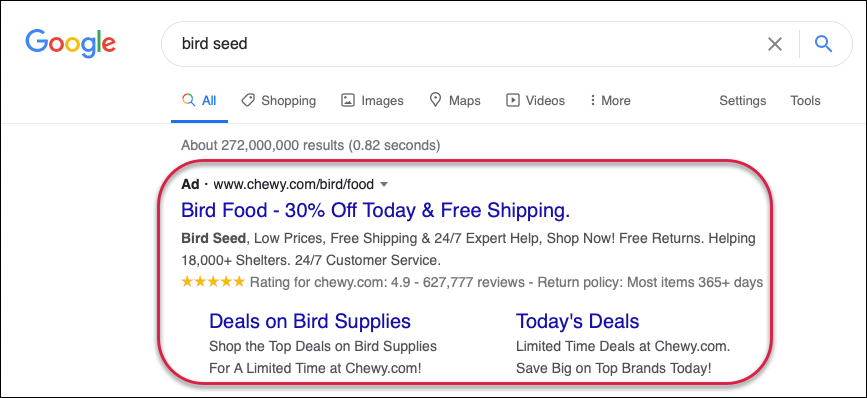
Display Campaign: Ads that feature images shown on different web pages within Google’s Display Network.
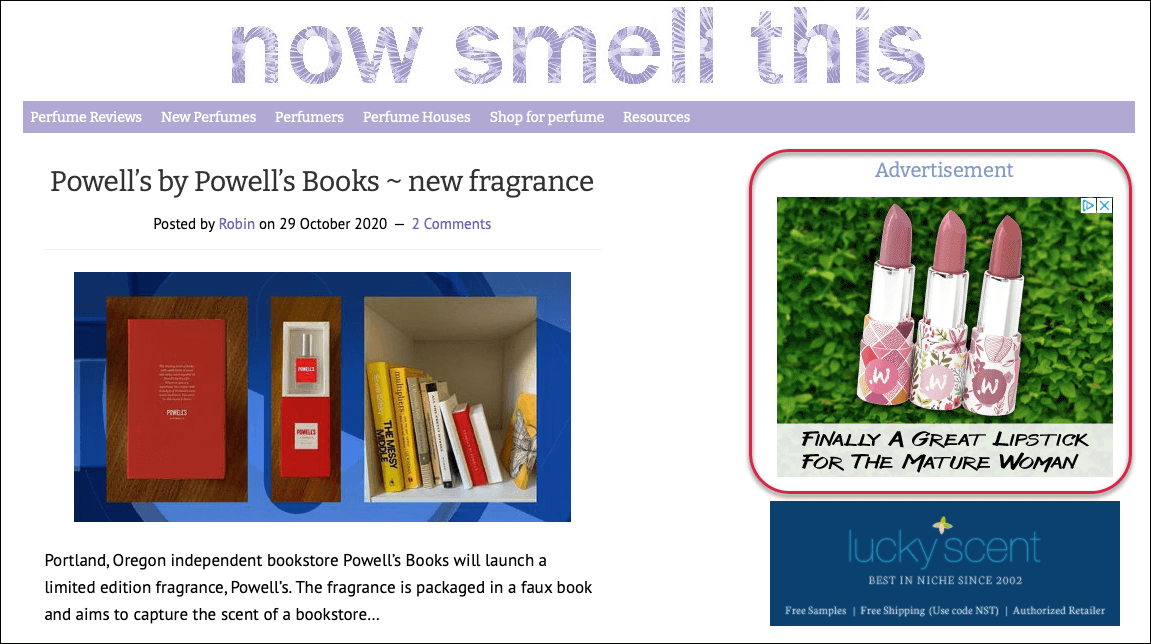
Shopping Campaign: For retailers promoting online and local inventory. Google will connect to your eCommerce Store via Google Merchant Center
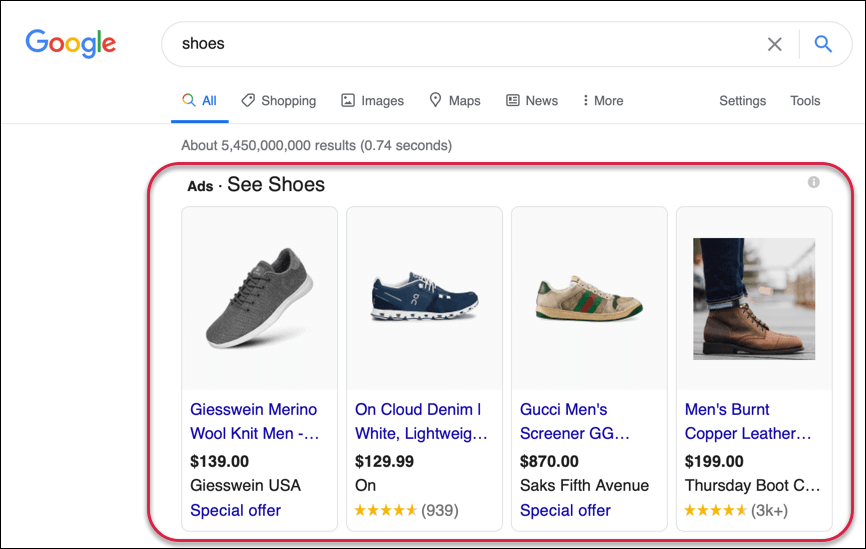
Video Campaign: 6-15 second videos that appear on YouTube pages.
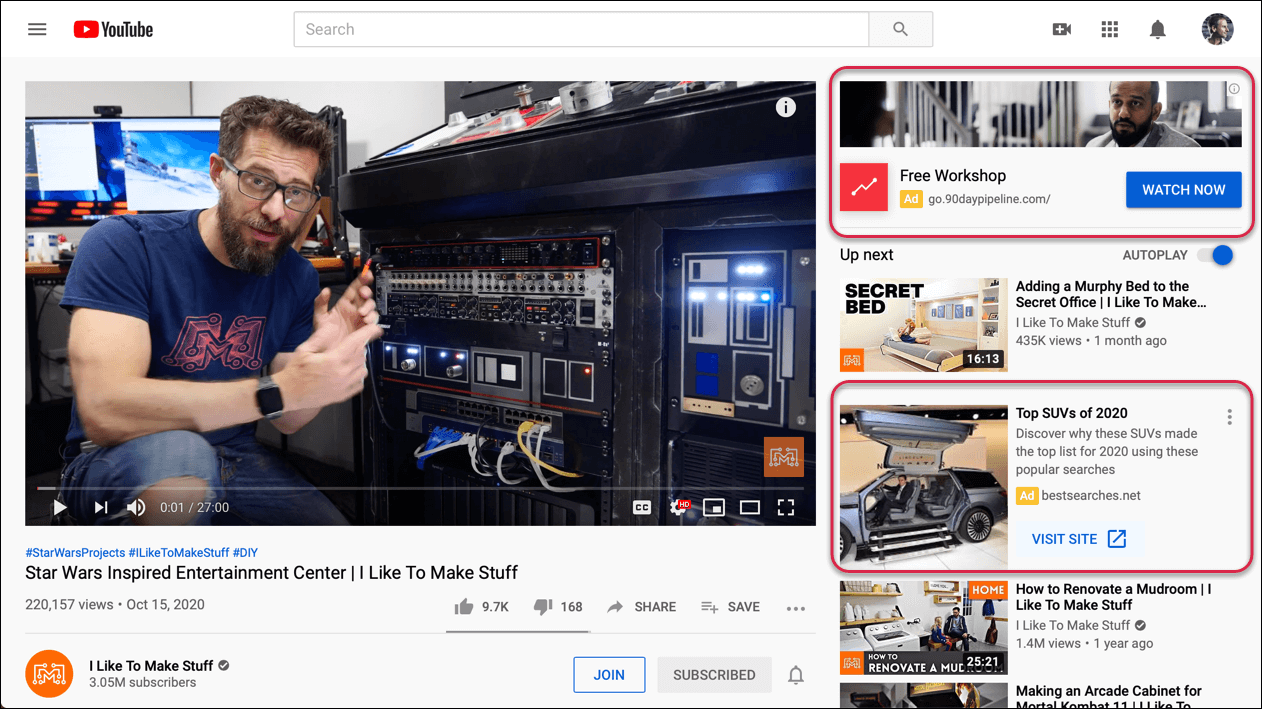
App Campaign: Allow you to advertise your app across Google’s different properties.

Display Network
The Google Display Network (or GDN) is a network of websites that allow Google Ads to be featured on their webpages; these can be text or image ads, and are shown on the same page as content that is relevant to your keywords. This is an optional setting for Google Ads users, just be sure to consider all the pros and cons of this feature before checking the GDN box.
Conversions
A conversion within Google ads happens when a user performs a specific action after clicking on one of your ads. While actions like page views and page scrolls can be counted as conversions, these are considered “micro conversions” and are much less indicative of your account’s true success. Instead, focus on “macro conversions” that measure more tangible actions like product purchases, document downloads, or lead form fills. Conversions can be tricky to set up properly, so make sure to do some research before diving in.
Keywords
Keywords in Google Ads are words or phrases chosen to match your ads with the terms users are searching for. Keywords are divided into the four match types below:
- Broad match: Your keyword will match your exact keyword, close variants, as well as related topics, and in any order. This match type should be used with caution and monitored closely to ensure you’re not spending your budget on searches that are irrelevant to your business.
- Exact match: Your keyword only matches searches identical to your exact keyword or phrase, or very close variants, and is designated with brackets.
- Phrase match: Your keyword will match searches with the exact same word order, but can include words before or after. They will also include searches where the “intent” is the same.For example, searching for “cooking classes near me” would also apply to “cooking courses near me” as the intent behind those words are the same. Phrase match is designated with quotation marks.
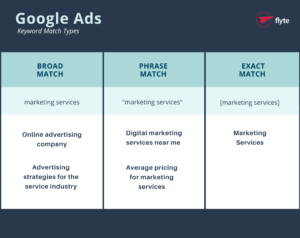
Ad Extensions
In traditional print advertising, the bigger the ad, the bigger the spend. But what if you could double the size of your ad without paying any extra money?
By using Ad Extensions, you can provide additional valuable information and increase the footprint of your ad on Google’s results pages…
While not every type of ad extension listed below is applicable to every business, you should use as many as possible. Please note that extensions labeled [BETA] are new to Google and currently only available to select advertisers.
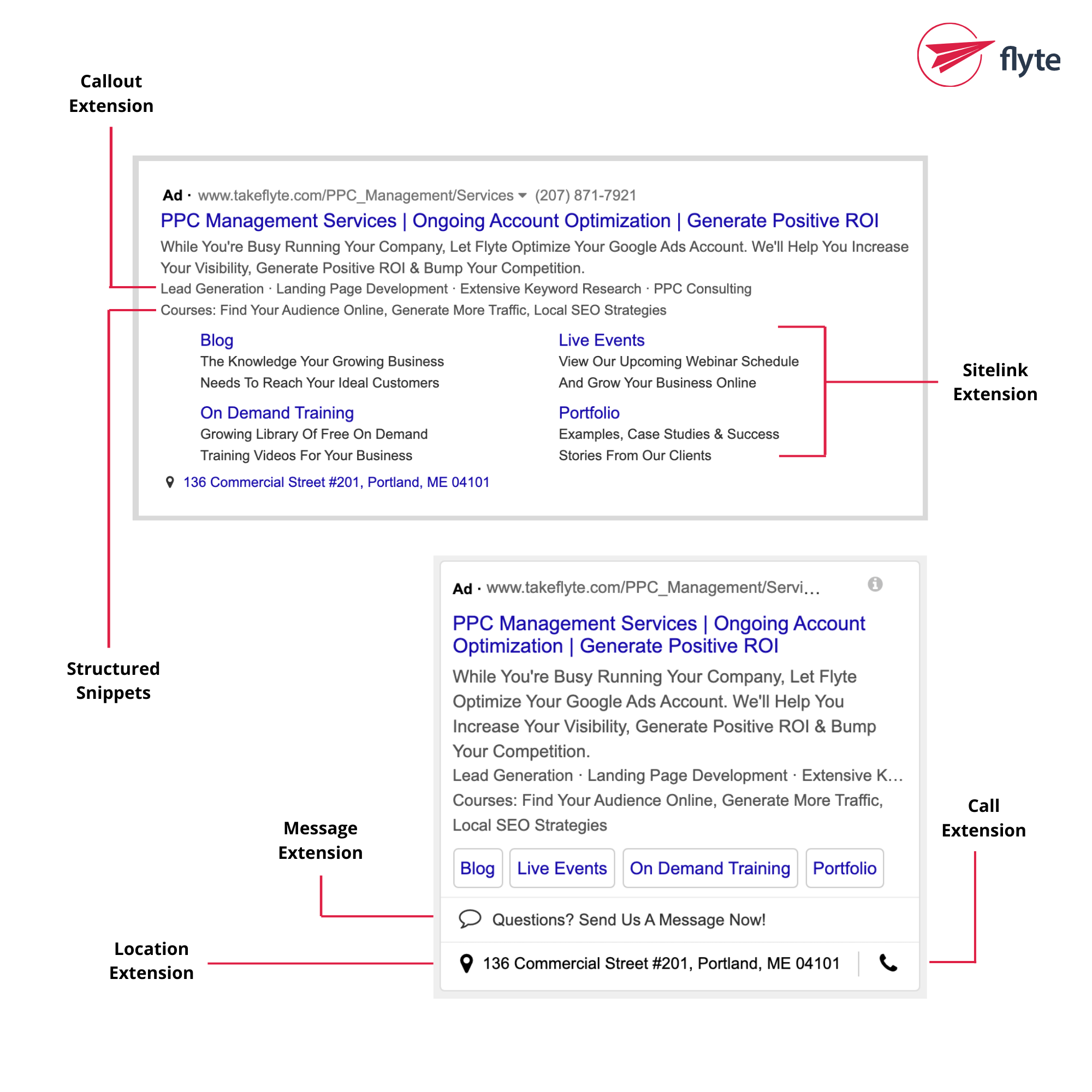
- Sitelink Extension: Sitelinks allow you to display links to pages outside your ad’s landing page, like links to your blog library, “About Us” page, events pages, etc.
- Call Extension: With more and more people searching on smartphones, click to call saves users time and lets them contact you right from your ad!.
- Callout Extension: What makes you stand out? Use examples like “Free shipping,” “24hr customer service,” and other unique aspects of your business. Consider this your elevator pitch in bullet form.
- Location Extension: Connect directly with your Google My Business location and display your address, distance from the user’s location to your address, or mapped directions to your address.
- Structured Snippets: Google provides 13 header options like “Amenities”, “Brands”, and “Courses” that highlight specific aspects of your products/services, which you’re able to follow with a short list of custom values you choose.
- Price Extension: Showcase your specific products and pricing within your ad, by clicking on these extensions your customers are taken directly to the product/service.
- Message Extension: Allows users to message you directly from your ad
- Promotion Extension: Display your business’s special sales and offers.
- Affiliate Location Extension: Designed for those who sell their products through retail chains, these extensions help users find nearby stores that sell those products.
- App Extension: Advertise your downloadable app to prospects.
- Lead Form Extension [BETA]: Enables users to provide their contact information directly through your ad, allowing you to collect leads directly.
- Image Extension [BETA]: Display a small photo next to your text ad on the SERP.
Ongoing Optimization for Google Campaigns
Bidding Strategies
Every ad created goes through a process called the ad auction that decides which ads will appear on Google’s SERP, and in what order they will appear based on the ad’s AdRank .
There are many bidding strategies within Google Ads, both manual and automated, but they can all be grouped into these five categories based on your goals:
- Conversion-Focused: When you want customers to take a specific, measurable action on your site.
- Increased Website-Traffic: When you want more traffic to your site.
- Brand Awareness: When you want to increase awareness and get in front of as many eyes as possible, clicks and conversions are an afterthought.
- Interaction Strategies [Video]: When you want to increase views or interactions on your video ads.
- Product Awareness [Video]: When you want to increase awareness through video ads.
Choosing the bidding strategy that suits your goals and your business is crucial to the success of your Google Ads campaign. For a deep dive and additional expert advice, this guide will help.
Negative Keywords
Negative keywords work exactly the same as regular keywords, but instead of choosing search terms you want your ads to show up for, you’re choosing the terms you don’t want your ads to show up for.
While there are some general terms that you can add immediately, adding negative keywords usually happens over time as you monitor the search terms your ads are showing up for, and adjust accordingly. Some commonly used negative keywords are things like “free”, “cheap”, your competitor’s names (although some businesses enjoy using Competitor Campaigns), and the five W’s (“who”, “what”, “where”, “when”, and “why”) that usually signal an informational search as opposed to one with commercial intent. While negative keywords will vary from industry to industry, the terms listed above are generally not conversion-friendly.
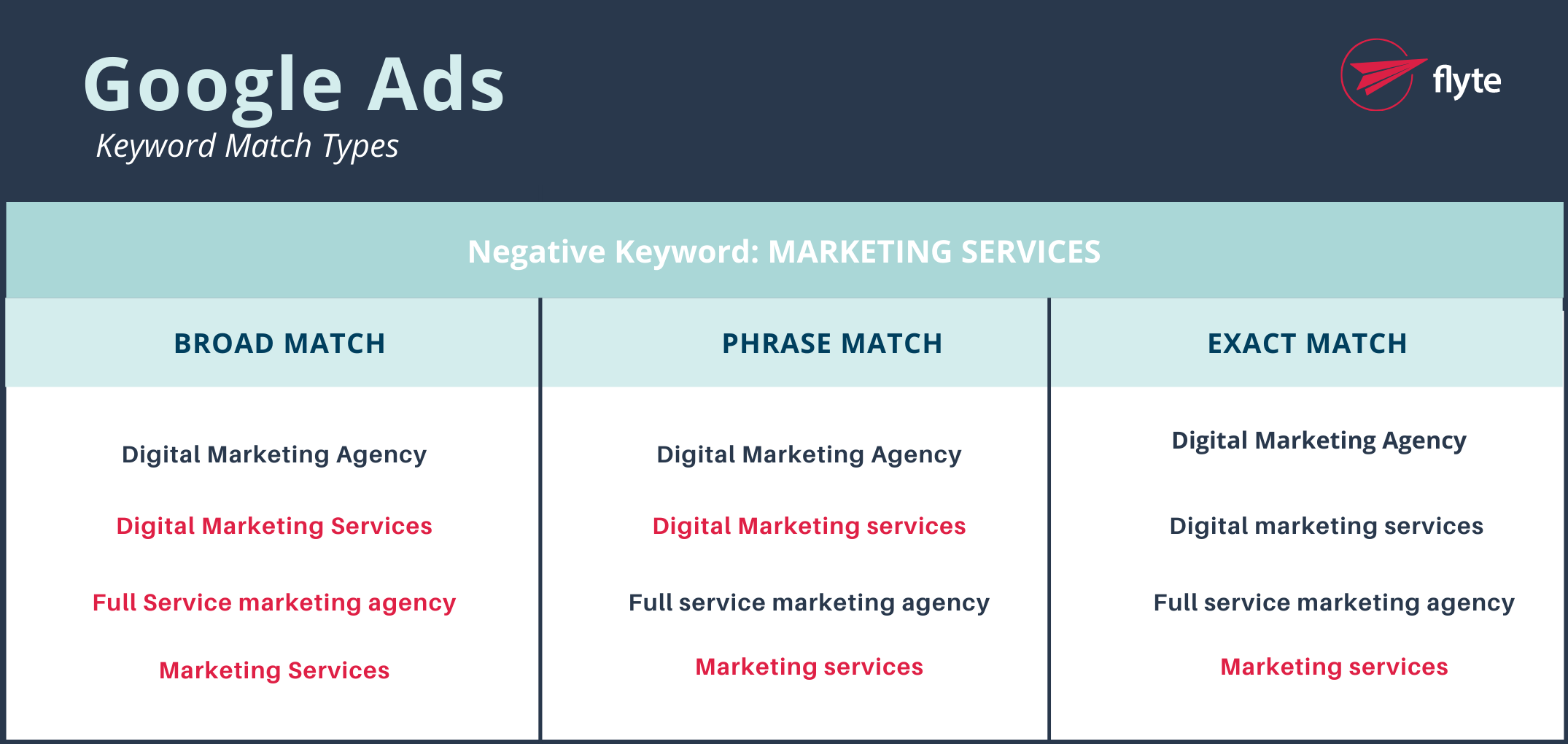
*Terms in red represent searches that would not trigger an ad to show
Reporting on Google Ad Campaigns
Reporting allows you to see just how well your ads have been performing, and what areas need attention. Don’t worry, Google also provides an ongoing list of their recommendations to optimize your account as you go, however, this can be a double-edged sword; If you’re not paying attention Google can take their recommendations and automatically add them to your account.
Impressions
Impressions represent the number of times your ad is shown on a search result page or within the Google Network; each time your ad is shown, it is counted as one impression, regardless of whether someone clicks on it or not
Click-through-rate
Click-through-rate (or “CTR”) is a vital metric to the success of your PPC campaign, and measures the rate at which users click your ads compared to the number of times the ad is viewed. CTR is calculated by dividing the number of people who click your ad by the number of people who viewed your ad–so the higher your CTR, the better.
CTR = (Clicks on ad) / (Total Impressions)
AdRank
This determines your Google Ads’ placement. The higher your AdRank, the higher you will appear on Google’s search pages and the more people will see your ads. This is determined by your maximum bid (the maximum amount advertisers are willing to pay for users to click your ads) and your Quality Score.
Quality Score
Your Quality Score is essentially Google’s way of “grading” your ads to determine how they should rank on the search engine. The higher your rank, the higher your ad placement will be; while low Quality Score leads to fewer impressions and fewer chances to gain conversions.
This is important! You can appear higher than another advertiser paying more than you if your Quality Score is better than theirs!
Quality Score is based on several factors listed below, and while Google will not reveal how much each factor influences Quality Score, it has been confirmed that click-through-rate is the most important.
- Click-through-rate
- How relevant your keywords are to the ad groups they appear in
- Landing page relevance and quality (make sure the page you send people to is relevant to the ad and of high quality)
- Ad text relevance (your ad should be relevant to the search just performed)
- Your historical Google Ads account performance
So, What Next?
If you’re feeling like you’ve got a solid grasp on the realm of PPC–go ahead and dive in!
Looking for some additional guidance before getting started? Here are a few resources:
If you’re still feeling out of your league or simply don’t have time to manage an entire Google Ads account, it may make sense to bring in a professional–even just to set up your account and get you started. I love working with Google Ads and would love to talk with you about your goals and objectives. If you’re interested, let’s set up a time to chat!
